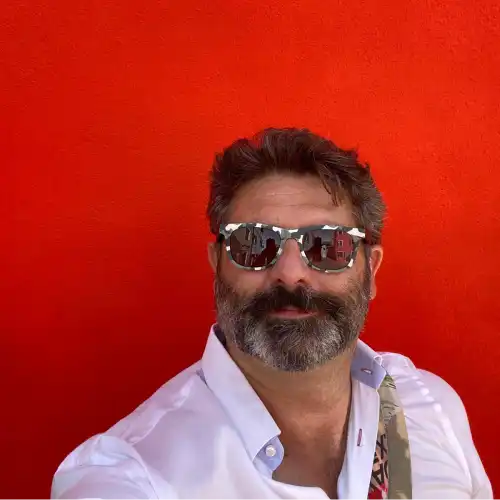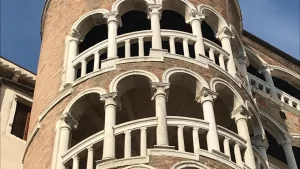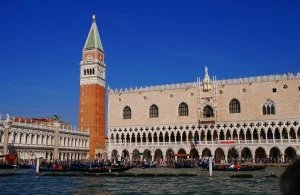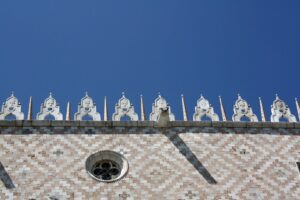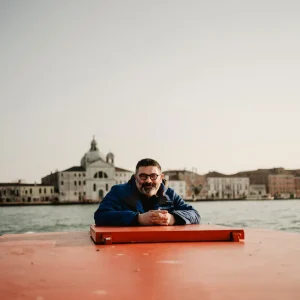Venice Restored: The City That Never Sleeps (Because It’s Always Being Repaired)
Walk through Venice today, and you’ll see it everywhere — scaffolding hugging churches, workers on ropes above the canals, and buildings veiled in white cloth. Some travelers sigh, thinking, “There goes my perfect photo.”
But here’s the truth:
👉 Without constant restoration, Venice wouldn’t exist at all.
Saltwater eats marble. Humidity softens frescoes. Even weeds sprout between centuries-old bricks. Venice is beautiful, but it’s also fragile — a city that needs daily care just to survive. And that endless work of preservation isn’t just necessary… it’s extraordinary to witness.
Let’s walk together through the city and its lagoon, exploring the major restoration projects bringing Venice back to life in 2025 — the ones you can see, feel, and appreciate (just not touch!).
⛪ First Stop: St. Mark’s Basilica — Guarding the Soul of Venice
Step inside St. Mark’s Basilica and you’ll understand why restorers call it “a living miracle.” Every surface gleams with golden mosaics, Byzantine marble, and light reflected like liquid gold. Yet every inch of that splendor is constantly under threat.
Those 1,000-year-old mosaics are cleaned and repaired piece by piece — one tiny gold tile at a time. Outside, new transparent glass barriers now protect the church from acqua alta (high tides) that used to flood its interior several times each winter.
When you see workers high on scaffolding inside the basilica, remember this: they’re not interrupting your photo — they’re saving history. Each artisan, brush in hand, is literally preserving Venice’s heart.
Story to remember: Next time you stand in St. Mark’s, imagine the centuries of hands that have cared for it — each one laying gold to ensure the city’s spirit still shines.
🏰 The Doge’s Palace — Restoring the Face of Power
Cross Piazza San Marco and enter the Doge’s Palace, the former seat of Venetian power. The marble arches, gilded ceilings, and Tintoretto’s vast paintings whisper of wealth and politics — and like everything else in Venice, they need constant healing.
In 2025, restorers have been working in the Room of the Four Doors — where ambassadors once waited to meet the Doge. They’re carefully cleaning frescoes dulled by centuries of candle smoke, stabilizing stucco decorations, and fixing cracks in ancient stone portals.
It’s slow, meticulous work — but without it, the palace’s message of “power and beauty” would literally crumble. Even when one section is under wraps, the palace remains open — and with a private guide, you can explore secret passages, prisons, and Tintoretto’s glowing masterpieces while understanding what it takes to keep them alive.
Tip: Ask your guide to show you where modern engineers discreetly reinforce 500-year-old ceilings — it’s living history in motion.
🎨 Tintoretto’s Resurrection at the Scuola Grande di San Rocco
Not all restorations happen behind closed doors. At San Rocco, one of Venice’s grand confraternity halls, visitors witnessed one of the city’s most breathtaking revivals: Tintoretto’s Crucifixion.
For two years, the enormous canvas — one of the largest ever painted — was hidden behind conservation screens. Restorers cleaned layers of grime, stabilized the canvas, and revived colors that hadn’t been seen since the 16th century.
When the painting was unveiled again in 2025, the effect was astonishing. The light, the movement, the human drama — it felt as if Tintoretto had just stepped out for coffee and would return any moment to finish a final brushstroke.
Story to tell: “I saw Tintoretto’s Crucifixion just after it was restored — and it looked like it was painted yesterday.”
🕍 Torcello — The Floor Where Venice Began
To understand where Venice’s story truly started, take a private boat to Torcello — the lagoon island that predates Venice itself. In its 11th-century basilica, artisans are currently restoring the mosaic floor of the presbytery, where early Venetians once prayed.
Parts of the church now serve as open conservation labs, with ancient tiles being cleaned, reassembled, and gently returned to their places. Roof repairs and humidity control systems are being completed to safeguard the church for another millennium.
When finished, visitors will once again walk across these glowing mosaics — quite literally stepping where Venice began.
Why it matters: Restoration here isn’t just art preservation — it’s time travel made tangible.
🎼 Music and Stucco at Palazzo Pisani
Not all Venetian restorations are museums. Some are alive with sound. Near Campo Santo Stefano, Palazzo Pisani — now home to the Conservatorio Benedetto Marcello — is being restored room by room while students practice violins, pianos, and arias inside.
Here, craftsmen are repairing stuccoes, frescoes, and marmorino plaster, while preserving original wood floors that creak beneath young musicians’ feet. The mix of music and restoration creates something special: Venice’s future growing within its past.
As one restorer put it, “Every hammer stroke here echoes with Bach.”
🎨 The Ceiling That Could Fall (But Won’t): San Pantalon
Hidden behind Campo San Pantalon stands one of Venice’s most surprising treasures — and most ambitious restorations. Inside, look up: the entire ceiling is covered by a single colossal painting by Giovanni Antonio Fumiani. It’s the largest canvas ceiling in the world, painted directly on cloth and suspended above you like a cloud.
For decades, Venetians jokingly called it “the ceiling that could fall on us.” Thankfully, it won’t — because restorers have reinforced its wooden supports and cleaned surrounding chapels and stuccoes, giving the church a renewed glow.
Fun fact: Fumiani spent 24 years painting it. Restorers have spent nearly as long keeping it standing.
🌿 The Bell Tower That Grew a Garden
Some Venetian restorations are less glamorous but no less heroic. In Castello, at San Francesco della Vigna, the 69-meter bell tower faced an unusual enemy — weeds.
Over the years, windblown seeds took root in its ancient bricks, their roots threatening to split the structure apart. Engineers used drones to map the growths, then climbers descended on ropes to remove the plants one by one, like sky-gardeners saving history.
Once cleared, the bricks were repointed and reinforced. The result? The tower stands proud again, proof that in Venice, even small victories matter.
🌸 Gardens Reborn: Il Redentore on Giudecca
Venice isn’t just marble and mosaics — it’s also green. On Giudecca, behind Palladio’s majestic Church of Il Redentore, lies a secret: restored monastic gardens where monks once cultivated herbs, fruit trees, and vines.
After years of neglect, these gardens have been replanted and reopened in 2025. Pergolas now bloom with grapes and roses, pathways are lined with lavender, and old irrigation systems have been brought back to life.
Visiting feels like stepping into another century — where silence, wind, and scent become part of the Venetian experience.
🖌️ From Tintoretto to Banksy: Modern Art Joins the Fight
Venice’s story of preservation doesn’t end with the Renaissance. In 2019, street artist Banksy left a mural of a migrant child in a life jacket holding a pink flare on a canal wall. Time and salt air soon began to damage it. In 2024, it was carefully removed for conservation.
The piece is now being restored in a private lab, funded by a Venetian bank, and will be displayed again soon — a reminder that Venice’s art heritage doesn’t stop at mosaics and marble. Even contemporary works deserve protection from the same elements that threaten ancient ones.
Lesson: From Byzantine icons to modern protest art, Venice protects beauty in all its forms.
🛠️ A City That Heals Itself
As you explore Venice in 2025, here’s what you might notice if you look closer:
- ✨ St. Mark’s Basilica glittering under new protective glass.
- 🏛️ The Doge’s Palace glowing with cleaned frescoes and polished marble.
- 🎨 Tintoretto’s Crucifixion reborn in radiant color.
- 🕍 Torcello’s mosaics being pieced together like an ancient puzzle.
- 🧱 Bell towers freed from invasive roots.
- 🌸 Monastic gardens blooming again on Giudecca.
- 🎭 Banksy’s mural restored for a new generation.
Behind each of these projects are Venetians, artisans, engineers, scientists, and donors — all working together to keep the city alive. Venice isn’t being “saved once and for all.” It’s being saved every single day.
🔍 How to See Restoration in Action
Most visitors walk past scaffolding without realizing they’re passing miracles in progress. But with a local expert, those barriers become stories — of art, science, and resilience.
- Why is this façade wrapped today?
- Who funds this work — and how?
- What does a fresco look like before and after cleaning?
At Tour Leader Venice, we turn restoration into revelation. Our private walking tours and lagoon experiences are timed to coincide with current conservation projects — so you can see history being repaired before your eyes. We explain the stories behind every scaffold, the artisans behind every brushstroke, and the passion that keeps Venice standing.
🛶 Discover Venice’s Living Heritage →
💬 Conclusion: Venice Restores, Venice Survives
Venice isn’t a museum frozen in time — it’s a living organism, breathing through restoration. Every cleaned fresco, every repaired floor, every weeded bell tower is an act of devotion, not just maintenance.
So when you see scaffolding, don’t sigh — smile. It means Venice is still fighting, still alive, and still being loved enough to mend.
Because as long as Venetians keep repairing their city, the world will keep falling in love with it.
✨ Explore Venice with Those Who Keep It Alive →
Why is Venice always under restoration?
Venice is built on water — and that beauty comes at a price. Salt, humidity, and time constantly erode its marble, bricks, and frescoes. Without continuous restoration, the city would literally dissolve. Each scaffold you see protects a masterpiece: from St. Mark’s golden mosaics to Tintoretto’s paintings and the bell towers of Castello. Venice survives because its residents, artisans, and engineers never stop repairing it. You can witness these efforts firsthand on our Venice Walking Tour of Living Heritage.
Can visitors see restoration projects while in Venice?
Yes — and it’s one of the most fascinating ways to understand the city. Several sites such as St. Mark’s Basilica, the Doge’s Palace, and Torcello’s Cathedral currently feature open conservation areas where visitors can glimpse restoration in progress. With a local guide, even a scaffold becomes a story — each project revealing centuries of craftsmanship. Join our private Venice city tour to explore where restorers, scientists, and artisans work side by side to keep Venice alive.
Who funds and carries out Venice’s restorations?
Venice’s restorations are a collaboration between local artisans, conservation institutes, universities, and international sponsors. Projects like Tintoretto’s Crucifixion at San Rocco or the replanting of Giudecca’s monastic gardens are often supported by a mix of public grants and private donations. Even modern works, like Banksy’s mural, are now part of the preservation effort. Our slow lagoon experiences and behind-the-scenes art tours reveal how Venice balances tradition, innovation, and passion in every repair.


